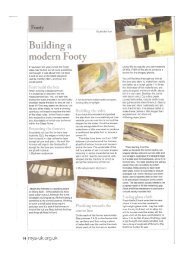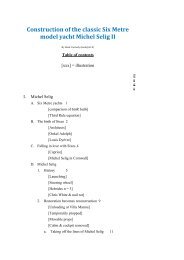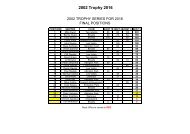Michel Selig II
The Construction of The Classic Six Metre Model Yacht Michel Selig II
The Construction of The Classic Six Metre Model Yacht Michel Selig II
Create successful ePaper yourself
Turn your PDF publications into a flip-book with our unique Google optimized e-Paper software.
d = a measurement of how much the hull has a<br />
"wine glass" shape<br />
F = the freeboard<br />
S = the sail area<br />
The International Rule also includes Eights, Twelves and even<br />
higher. The numbers of their names correspond to the solution<br />
of the equation. If the equation gives a result less than 6, it will<br />
qualify as a Six . Ditto for the other names.<br />
B. The birth of Sixes<br />
1907 was at the highpoint of the first worldwide globalisation<br />
period. It ended with WW I.<br />
This globalisation also extended to yachtsmen of various<br />
European countries who wanted to race against each other with<br />
equivalent boats. The Rule permitted naval architects of these<br />
countries to come up with their best designs for boats whose<br />
parameters conformed to the Rule. In each country, yachtsman<br />
commissioned boats from these architects and then raced them<br />
in international competitions. The best architects were:<br />
William Fife (UK)<br />
Johan Anker<br />
(Norway)<br />
Torre Holm<br />
(Sweden)<br />
Gustav Estlander<br />
(Finland)<br />
Olin Stephens (USA)<br />
The first international race of Sixes was sailed in 1907 on the<br />
Seine River in France at Meulan, organised by the Cercle de<br />
Voile de Paris. When the current was too strong, the boats<br />
anchored. They also ran aground on the mud flats. It was won<br />
by the German entry, Onkel Adolph, pictured below:







